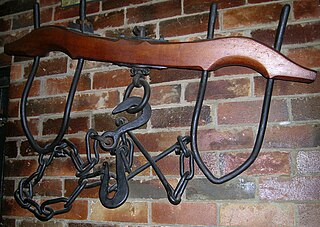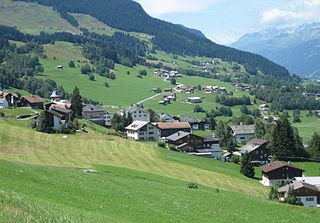Related Research Articles
The foot (pl. feet), standard symbol: ft, is a unit of length in the British imperial and United States customary systems of measurement. The prime symbol, ′, is a customarily used alternative symbol. Since the International Yard and Pound Agreement of 1959, one foot is defined as 0.3048 meters exactly. In customary and imperial units, one foot comprises 12 inches and one yard comprises three feet.

Wichtrach is a municipality in the Bern-Mittelland administrative district in the canton of Bern in Switzerland.

Val Müstair is a municipality in the Engiadina Bassa/Val Müstair Region in the Swiss canton of Graubünden. It was formed on 1 January 2009 through the merger of Tschierv, Fuldera, Lü, Valchava, Santa Maria Val Müstair and Müstair.

Lucens is a municipality in the Broye-Vully district in the canton of Vaud in Switzerland. In 2017 the former municipalities of Brenles, Chesalles-sur-Moudon, Cremin, Forel-sur-Lucens and Sarzens merged into the municipality of Lucens.
Waldstätte is a term, which has been used since the early thirteenth century to refer to the Stätte, or later Ort or Stand of the early confederate allies of Uri, Schwyz and Unterwalden in Central Switzerland.

Thunstetten is a municipality in the Oberaargau administrative district in the canton of Bern in Switzerland.

Fraubrunnen is a municipality in the Bern-Mittelland administrative district in the canton of Bern in Switzerland. On 1 January 2014 the former municipalities of Büren zum Hof, Etzelkofen, Grafenried, Limpach, Mülchi, Schalunen and Zauggenried merged into the municipality of Fraubrunnen.

Kemmental is a municipality in the district of Kreuzlingen in the canton of Thurgau in Switzerland.

Alto Malcantone is a municipality in the district of Lugano in the canton of Ticino in Switzerland. It was formed on 13 March 2005 from the earlier municipalities of Arosio, Breno, Fescoggia, Mugena and Vezio.

Safiental is a municipality in the Surselva Region in the canton of Graubünden in Switzerland. The municipalities of Valendas, Versam, Safien and Tenna merged on 1 January 2013 into the new municipality of Safiental.

La Sonnaz is a municipality in the district of Sarine in the canton of Fribourg in Switzerland. The municipality was created in 2004 through the merger of Cormagens, La Corbaz and Lossy-Formangueires. The municipal administration, the kindergarten and the primary school are in Lossy.

Casti-Wergenstein or Casti-Vargistagn is a former municipality in the Viamala Region in the Swiss canton of Graubünden. On 1 January 2021 the former municipalities of Casti-Wergenstein, Donat, Lohn and Mathon merged to form the new municipality of Muntogna da Schons.

Grono is a municipality in the Moesa Region in the Italian speaking part of the Swiss canton of Grisons. On 1 January 2017 the former municipalities of Leggia and Verdabbio merged into the municipality of Grono.

La Baroche is a municipality in the district of Porrentruy in the canton of Jura in Switzerland. It was founded at January 1, 2009 by the former municipalities of Asuel, Charmoille, Fregiécourt, Miécourt and Pleujouse.

Gampel-Bratsch is a municipality in the district of Leuk in the canton of Valais in Switzerland. It was formed on January 1, 2009. The voters of the municipalities of Gampel and Bratsch decided to merge on January 20, 2008.

Basse-Allaine is a municipality in the district of Porrentruy in the canton of Jura in Switzerland. On 1 January 2009 the former municipalities of Buix, Courtemaîche and Montignez merged to form Basse-Allaine.

A yoke was a unit of land measurement used in Kent in England at the time of the Domesday Book for tax purposes. It was equal to a quarter of a sulung. A sulung was the amount of land which could be ploughed by 4 ox-pairs, therefore a yoke was a pair of oxen, representing the amount of land that could be cultivated by an ox pair. A yoke also described the device used to harness two oxen together.

Gibloux is a municipality in the district of Sarine in the canton of Fribourg in Switzerland. The municipality was formed 1 January 2016, from the merger of Corpataux-Magnedens, Farvagny, Le Glèbe, Rossens and Vuisternens-en-Ogoz.

Obersaxen Mundaun is a municipality in the Surselva Region in the Swiss canton of Graubünden. On 1 January 2016 the former municipalities of Obersaxen and Mundaun merged to form the new municipality of Obersaxen Mundaun.

The klafter is an historical unit of length, volume and area that was used in Central Europe.
References
- ↑ Christian Noback, Friedrich Eduard Noback: Vollständiges Taschenbuch der Münz-, Maß- und Gewichtsverhältnisse. Book 1, F. A. Brockhaus, Leipzig 1851, pg. 463
- 1 2 3 4 5 6 7 Juchart in German , French and Italian in the online Historical Dictionary of Switzerland .
- ↑ Tagehri in German , French and Italian in the online Historical Dictionary of Switzerland .
- 1 2 Mal in German , French and Italian in the online Historical Dictionary of Switzerland .
- 1 2 Journal in German , French and Italian in the online Historical Dictionary of Switzerland .
- ↑ Béquille in German , French and Italian in the online Historical Dictionary of Switzerland .
- ↑ Chaîne in German , French and Italian in the online Historical Dictionary of Switzerland .
- 1 2 Mannwerk [Mannsmad] in German , French and Italian in the online Historical Dictionary of Switzerland .